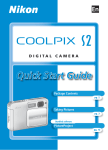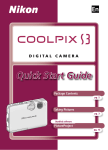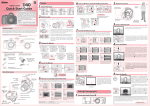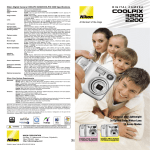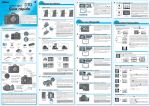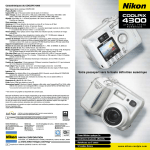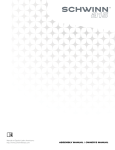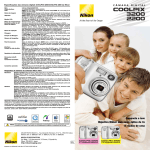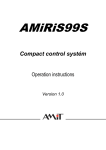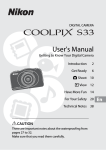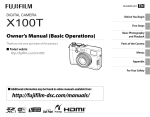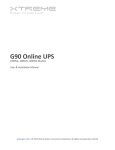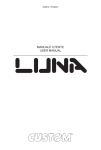Download Nikon COOLPIX S4 User's Manual
Transcript
En D I G I TA L C A M E R A Quick Start Guide Package Contents pg. 2 Taking Pictures pg. 3 Bundled software PictureProject pg. 14 Package Contents Check that you have all the items listed below. En En The Nikon Guide to Digital Photography with the D I G I TA L C A M E R A DIGITAL CAMERA Quick Start Guide Quick Start Guide (this guide) COOLPIX S4 digital camera and Rechargeable EN-MH1-B2 batteries (× 2) Guide to Digital Photography with the COOLPIX S4 or LR6 (AA) alkaline batteries (× 2) MH-71 battery charger with power cable (shape of cord depends on country of use) (also available as options) Camera strap UC-E6 USB cable EG-CP14 audio/video cable Warranty Lens cap Warranty PictureProject installer CD (yellow) PictureProject reference manual CD (silver) Depending on the country or region of purchase, the package will include either alkaline batteries or an MH-71 battery charger with rechargeable EN-MH1-B2 batteries. NOTE: Memory card not provided. See page 81 of the Guide to Digital Photography for a list of approved memory cards. 2 Taking Pictures Attach the camera strap and lens cap Attach the strap as shown. To ensure that the camera is not dropped and damaged, attach the strap as shown and wear it around your neck while using or carrying the camera. Adjust to length shown if wearing around neck. Attach the camera strap and lens cap Attach the lens cap as shown. Lens cap Attach as shown. Cap will click into place when hinge is correctly seated. The lens cap can be opened (�) and closed (�) while still attached to the camera. 1 2 3 Taking Pictures Charge the batteries If your camera came with alkaline batteries, skip this step and proceed directly to Step 3. 1 Connect the power cable to the charger (�) and then plug it into a power outlet (�). The CHARGE lamp will light (�). 3 1 2 2 Insert the batteries as indicated on the charger. The CHARGE lamp will start to blink. Charging is complete when the CHARGE lamp stops blinking. Charge the batteries A pair of new or fully exhausted batteries will charge in about two and a half hours. 4 Taking Pictures Insert the batteries 1 Open the battery-chamber cover Press the battery-chamber latch (�) and slide the cover in the direction shown (�) until it opens (�). 1 3 2 Insert the batteries Insert the batteries as shown in the label at the entrance to the battery chamber, making sure that the positive (“+”) and negative (“–”) terminals are in the correct orientation. 3 Close the battery-chamber cover Close the cover (�) and slide it in until it latches (�). Insert the batteries 2 1 2 5 Taking Pictures Turn the camera on 1 Select mode Slide the mode selector to 2 Turn the camera on Press the power switch until the power-on lamp lights. (auto mode). Auto Power off (Stand-by Mode) Turn the camera on If no operations are performed for about five seconds, the monitor will gradually dim to save power. Full brightness can be restored by pressing the shutter-release button or operating any of the controls on the back of the camera. If no operations are performed for about a minute, the monitor will turn off altogether and the camera will enter stand-by mode, further reducing the drain on the battery. The display can be reactivated by pressing the shutter-release button halfway. The camera will turn off automatically if no operations are performed for another three minutes. See the Guide to Digital Photography for more information on the options available for auto power off. 6 Taking Pictures Choose a language and set the clock The first time the camera is turned on, a language-selection dialog will be displayed in the monitor. Follow the steps below to choose a language and set the time and date. Use the multi selector to navigate the menus. Move cursor up Press left, right, up, or down Press center ( ) to make selection Display sub-menu, move cursor right, or make selection Cancel and return to previous menu, or move cursor left Move cursor down 1 2 DATE Set time and date? Cancel Confirm Highlight language. 3 DATE Confirm Confirmation dialog displayed. 4 Set time and date? Choose a language and set the clock No Yes TIME ZONE London, Casablanca DaylightSaving No Yes Confirm Highlight Yes. Confirm TIME ZONE menu displayed. * * To turn daylight saving time on or off, press multi selector down to highlight DaylightSaving and press center of multi selector. When DaylightSaving is checked, time will automatically be advanced one hour. To return to Step 4, press multi selector up to highlight current time zone. 7 Taking Pictures 5 HOME TIME ZONE 6 London, Casablanca Back Confirm Madrid, Paris, Berlin Back Confirm Display map of world time zones. 7 DATE D M Y Select home time zone. 8 01 . 01 . 2005 00 : M : M Y : 00 Edit Day (order of Day, Month, and Year may differ in some areas). Y 10 01 . 10 . 2005 00 D 01 . 01 . 2005 00 DATE D DATE 00 Display DATE menu. 9 HOME TIME ZONE DATE D M Y 01 . 10 . 2005 00 15 : 10 Choose a language and set the clock Confirm Select Month. Repeat 8 – 9 to edit Month, Year, hour, and minute. 11 DATE D M Y Highlight D M Y. 12 01 . 10 . 2005 15 : 10 Confirm Choose order in which Day, Month, and Year will be displayed. 8 AUTO Exit to shooting mode. 9 Taking Pictures Choose the battery type This step is only required with alkaline batteries. If your camera came with EN-MH1-B2 NiMH batteries, skip this step and proceed directly to “Take pictures”. 1 SHOOTING MENU 1/2 SET-UP Image mode White balance Exp. +/Continuous Exit Confirm Help 2 Highlight SET-UP. Display shooting menu. 3 SET-UP Shooting g menu Welcome screen Date Brightness Date imprint Exit Confirm 1/4 4 Help Display setup menu. 5 Alkaline COOLPIX(NiMH) Lithium 6 Confirm Help Alkaline COOLPIX(NiMH) Lithium Confirm Highlight Alkaline. 3/4 Help Select and return to setup menu. Choose the battery type SET-UP Interface AF assist Reset all Battery type Menus Exit Confirm 3/4 BATTERY TYPE Exit Display options. 7 SET-UP Interface AF assist Reset all Battery type Menus Exit Confirm Highlight Battery type. BATTERY TYPE Exit SHOOTING MENU 1/2 SET-UP Image mode White balance Exp. +/Continuous Exit Confirm Help 8 AUTO 9 Exit to shooting mode. Replacing the Batteries After inserting new batteries, check that the correct type is selected in the Battery type menu as described on page 80 of the Guide to Digital Photography. 9 Taking Pictures Take pictures 1 Check indicators in the monitor AUTO AUTO Number of exposures remaining Battery level indicator: Battery level is shown as follows: Display Description NO ICON Batteries fully charged. Low battery. Ready spare batteries. WARNING!! Batteries exhausted. No pictures can be taken until fresh batBATTERY teries are inserted. EXHAUSTED 2 Rotate the lens to shooting position The lens can be gently roForward tated up to 180 ° forward from the storage position or 90 ° back to face the user. 0° Back (toward monitor) Take pictures Do not use force or attempt to rotate the lens past the limits shown. 90° 180° Range of rotation 10 Taking Pictures Ready the camera Hold the camera steadily in both hands. 3 Don’t Block the Shot Important 4 To avoid dark or partially obscured pictures, keep your fingers and other objects away from the lens and flash window. If attached, the lens cap should be fully open as shown at right. Frame the subject Position the subject in the center of the frame and use the zoom control to compose the picture. Zoom in Zoom out Zoom control: Press the zoom control to T to zoom in on the subject so that it fills a larger area of the frame. Select W to zoom out, increasing the area visible in the frame. Take pictures Where Are My Pictures Stored? The camera stores pictures in internal memory (approximately 13.5 MB) or on removable Secure Digital (SD) memory cards (available separately; a list of approved memory cards is provided on page 81 of the Guide to Digital Photography). Pictures are stored in internal memory when no memory card is inserted. 11 Taking Pictures The COOLPIX S4 has a two-stage shutter-release button. Pressing the shutter-release button halfway focuses the camera. Pressing it the rest of the way down releases the shutter to record a picture. Focus Press the shutter-release button halfway to set focus and exposure. In mode, the camera will automatically focus on the subject at the center of the frame. Focus and exposure will lock while the shutterrelease button is pressed halfway. 5 With the shutter-release button pressed halfway, check the focus and flash indicators: AUTO Focus indicator On (green) Subject in focus. Camera unable to focus. Change compoBlinks red sition and try again. Flash lamp 6 AUTO On (red) Flash will fire when picture is taken. Blinks red Flash charging. Off Flash off or not required. Take the picture Press the shutter-release button the rest of the way down to take the picture. To prevent blur, press the shutter-release button down smoothly. 10 Take pictures 12 AUTO AUTO 10 Taking Pictures View pictures Press the button A picture will be displayed in the monitor. 1 (playback) button 2 View previous picture View next picture 3 When the camera is off, pressing the button for about one second will turn the camera on with a picture displayed in the monitor. View additional pictures Press the multi selector down or right to view pictures in the order recorded, up or left to view pictures in reverse order. Keep the multi selector pressed to scroll quickly to the desired frame. To return to shooting mode, press button again. the Turn the camera off Press the power switch. The camera is off when the power-on lamp is off. View pictures Now that you’ve taken a few pictures, you can install PictureProject and transfer (copy) them to your computer as described on the following pages. 13 PictureProject Bundled software Once the supplied PictureProject software has been installed, pictures can be transferred to a computer for easy viewing and storage. System Requirements for PictureProject Windows pg. 15 300 MHz Pentium or better recommended (550 MHz Pentium III or better for muvee option) Preinstalled versions of Windows XP Home Edition, Windows XP OS Professional, Windows 2000 Professional, Windows Millennium Edition (Me), or Windows 98 Second Edition (SE) Hard disk space 60 MB required for installation RAM Minimum 64 MB (128 MB with muvee option) Video resolution 800 × 600 or more with 16-bit color (High Color) or better Miscellaneous Only computers with built-in USB ports supported CPU Macintosh pg. 19 Mac OS X version 10.1.5 or later (version 10.2.8 or later required for Burn Disc option) Hard disk space 60 MB required for installation RAM Minimum 64 MB 800 × 600 or more with 16-bit color (thousands of colors) or Video resolution better Miscellaneous Only computers with built-in USB ports supported OS For the latest information on supported operating systems, visit: • http://www.europe-nikon.com/support (for users in Europe and Africa) • http://www.nikon-asia.com/ (for users in Asia, Oceania, and the Middle East) Install PictureProject Install PictureProject Before Connecting the Camera Important If PictureProject is not installed when the camera is connected, a hardware wizard may be displayed. Click Cancel to exit and then disconnect the camera. Other Nikon Software (Nikon View / Nikon Capture) Uninstall Nikon View before installing PictureProject. For information on using PictureProject with Nikon Capture, see the PictureProject Reference Manual (on CD). 14 Bundled software Install PictureProject PictureProject Windows Windows Windows XP / Windows 2000 1 Log on to an account with administrator privileges when installing or uninstalling PictureProject under Windows XP Home Edition, Windows XP Professional, or Windows 2000 Professional. Windows Important Turn the computer on and wait for Windows to start up. Before proceeding to the next step, turn off any virus-checking software and exit any other applications that may be running. 2 Insert the PictureProject installer CD into the CD-ROM drive. The Install Center program will launch automatically and a “Select Region” dialog will be displayed. Select a region and click Next. (The “Select Region” dialog is not displayed in the European release of PictureProject. European users can proceed directly to Step 3 .) 3 A language selection dialog will be displayed. Select a language and click Next. Install PictureProject If the “Select Region” or “Select Language” Dialog Is Not Displayed Open the “My Computer” window by selecting My Computer from the Start menu (Windows XP Home Edition / Windows XP Professional) or by double-clicking the My Computer icon on the desktop (other versions of Windows) and then double-click the CD (PictureProject) icon. 15 PictureProject Bundled software Click Easy Install to begin installation of the following software: • PTP drivers for COOLPIX-series cameras (Windows XP only) • Nikon Mass Storage Camera Drivers (Windows 98 SE only) • Panorama Maker • Apple QuickTime 6 • Nikon FotoShare (Europe only) • PictureProject • Microsoft DirectX 9 5 The first components to be installed are the camera drivers. The drivers installed depend on the computer’s operating system: • Windows XP: Follow the on-screen instructions to install the PTP driver (on some systems the driver may be installed by a wizard). Windows 4 • Windows 2000 /Windows Me: No drivers are installed. Proceed to Step 6 . • Windows 98 SE: Follow the on-screen instructions to install the Mass Storage Drivers. Install PictureProject 16 6 The Panorama Maker install wizard will start. Follow the on-screen instructions to complete installation. 7 Click Yes to install QuickTime. Bundled software The Nikon FotoShare setup program will start (Europe only). Follow the on-screen instructions to complete installation. 9 The PictureProject setup program will now start. After reading the license agreement, click Yes to accept the agreement and proceed with installation. 10 Click Next to install PictureProject to the location shown under “Destination Folder,” or click Browse… to choose a different folder. Complete the following steps: Windows 8 PictureProject 1 Click Yes when prompted to create a new folder. 2 To create a shortcut to PictureProject on the desktop, click Yes when prompted. 3 Click Finish to exit the PictureProject installer. Install PictureProject 11 Panorama Maker and muvee options require DirectX version 9 or later. If an earlier version is installed, the dialog shown at right will be displayed. Follow the onscreen instructions to install DirectX 9. 17 PictureProject 12 Bundled software Click Finish or Yes to restart the computer. Windows Displayed if DirectX is installed 13 Displayed if DirectX is not installed When the computer restarts, the PictureProject Import Assistant will be displayed. The Import Assistant is used to catalog pictures already on the computer for display in PictureProject. To proceed without cataloging existing pictures, click Close (existing pictures can be cataloged manually at any time; see the PictureProject reference manual for details). For more information on importing pictures into PictureProject, see the PictureProject Reference Manual (on CD). 14 Remove the PictureProject installer CD from the CD-ROM drive. Install PictureProject Software updates If the computer is connected to the Internet, PictureProject will periodically check for updates. If an update is detected when PictureProject starts, an update dialog will be displayed. Follow the on-screen instructions to update to the latest version of PictureProject. This completes installation of PictureProject. The next step is to transfer pictures to your computer as described on page 23. 18 Bundled software Install PictureProject PictureProject Windows Macintosh Installing or Uninstalling PictureProject Important 1 Log on to an account with administrator privileges when installing or uninstalling PictureProject. Turn the computer on and wait for it to start up. Before proceeding to the next step, turn off any virus-checking software and exit any other applications that may be running. 3 A language selection dialog will be displayed. Select a language and click Next. 4 Click Easy Install to begin installation of the following software: • Panorama Maker • PictureProject • Apple QuickTime 6 (if required) Once installation is complete, European users can install Nikon FotoShare by copying the “FotoShare” icon to the hard disk (Step 12 ). Install PictureProject Insert the PictureProject installer CD into the CD-ROM drive. Double-click the PictureProject installer CD icon on the desktop, then double-click the Welcome icon. The “Select Region” dialog will be displayed. Select a region and click Next. (The “Select Region” dialog is not displayed in the European release of PictureProject. European users can proceed directly to Step 3 .) Macintosh 2 19 PictureProject Macintosh Install PictureProject 20 Bundled software 5 The Panorama Maker installer will start. Follow the on-screen instructions to complete installation. 6 The message shown at right will be displayed (Europe only; users in other areas can proceed directly to Step 7 ). Click OK. 7 Enter your administrator name and password and click OK. 8 The PictureProject license agreement will be displayed. After reading the license agreement, click Accept to accept the terms and conditions of the agreement and view the ReadMe file. Take a few moments to read this file, which may contain important information that could not be included in this manual. After viewing the ReadMe file, click Continue to proceed with installation. Bundled software 9 PictureProject The PictureProject installer will start. Click Install and follow the steps below: To have PictureProject Transfer start automatically when the camera is connected, click Yes when prompted. 2 Click Yes to add PictureProject to the Dock. 3 Click Quit to exit the PictureProject installer. Macintosh 1 Apple QuickTime 6 If an earlier version of QuickTime is installed, the QuickTime 6 installer will start automatically. Follow the on-screen instructions to complete installation. When the dialog shown at right is displayed, click Continue. Do not complete the “Registered To,” “Organization,” and “Registration Number” fields. On some systems, the QuickTime installer may require considerable time to complete installation. 10 Click Restart to restart the computer. Install PictureProject Displayed if QuickTime 6 is not installed Displayed if QuickTime 6 is installed 21 PictureProject 11 Bundled software When the computer restarts, log in to the “Admin” account. The PictureProject Import Assistant will be displayed. The Import Assistant is used to catalog pictures already on the computer for display in PictureProject. To proceed without cataloging existing pictures, click Close (existing pictures can be cataloged manually at any time; see the PictureProject reference manual for details). Macintosh For more information on importing pictures into PictureProject, see the PictureProject Reference Manual (on CD). 12 After exiting the Import Assistant, open the “FotoShare” folder on the PictureProject installer CD and install Nikon FotoShare by dragging the Nikon FotoShare icon to the “Applications” folder on the hard disk (note that FotoShare is included only with the European release of PictureProject). When copying is complete, remove the PictureProject installer CD from the CD-ROM drive. Software updates If the computer is connected to the Internet, PictureProject will periodically check for updates. If an update is detected when PictureProject starts, an update dialog will be displayed. Follow the on-screen instructions to update to the latest version of PictureProject. Install PictureProject This completes installation of PictureProject. The next step is to transfer pictures to your computer as described on the following page. 22 Bundled software PictureProject View pictures on a computer 1 Turn the camera off. 2 Connect the USB cable as shown below. Connect the camera directly to the computer; do not connect the cable via a USB hub or keyboard. Do not use force. UC-E6 USB cable 3 Turn the camera on. PictureProject will automatically detect the camera and the PictureProject Transfer window will be displayed in the computer monitor. Click Transfer to copy all the pictures in the camera memory to the computer. View pictures on a computer Windows Macintosh Windows XP If the dialog shown at right is displayed, select Copy pictures to a folder on my computer using PictureProject and click OK. To bypass this dialog in future, check Always do the selected action. 23 PictureProject 4 Bundled software The pictures will be displayed in PictureProject when transfer is complete. Windows Macintosh During Transfer Important View pictures on a computer While transfer is in progress, do not: • Disconnect the USB cable • Turn the camera off • Remove the batteries or memory card • Disconnect the AC adapter Failure to observe this precaution could interfere with normal functioning of both the camera and the computer. Use a Reliable Power Source Nikon recommends using the optional EH-62B AC adapter kit to power the camera for extended periods. Do not use another make or model of AC adapter. 24 Bundled software PictureProject The main controls in the PictureProject window are shown below: Organize button: Click to view and organize pictures. Edit button: Click to enter edit mode, where you can crop pictures, adjust brightness and hue, and use other retouch tools. Collection list: Group pictures into collections. Design button: Click to arrange pictures in a variety of layouts. View pictures on a computer Picture list: View the pictures in the current collection or folder. PictureProject can also be used for a variety of other tasks, including printing pictures, sending pictures by e-mail, viewing slide shows, creating muvee videos (Windows only), and copying pictures to CD or DVD (requires Windows or Mac OS X version 10.2.8 or later). 25 PictureProject 5 Bundled software Once your pictures are displayed in PictureProject, transfer is complete and you can disconnect the camera. Disconnecting the Camera Before turning the camera off or disconnecting the USB cable, remove the camera from the system as described below. Windows XP Home Edition /Windows XP Professional Click the “Safely Remove Hardware” icon ( ) in the taskbar and select Safely remove USB Mass Storage Device from the menu that appears. Windows 2000 Professional Click the “Unplug or Eject Hardware” icon ( ) in the taskbar and select Stop USB Mass Storage Device from the menu that appears. Windows Millennium Edition (Me) Click the “Unplug or Eject Hardware” icon ( ) in the taskbar and select Stop USB Disk from the menu that appears. View pictures on a computer Windows 98 Second Edition (SE) In My Computer, click with the right mouse button on the removable disk corresponding to the camera and select Eject from the menu that appears. Macintosh Drag the camera volume (“NO NAME”) into the Trash. 26 Bundled software PictureProject You have now taken pictures and copied them to your computer. This completes the COOLPIX S4 Quick Start Guide. To make the most of all the features of your Nikon digital camera, be sure to read the Guide to Digital Photography. Viewing the PictureProject Reference Manual The PictureProject manual may be found on the PictureProject reference manual CD. Insert the PictureProject reference manual CD in a CD-ROM drive. 2 Double-click the CD icon. • Windows: Open “My Computer” and double-click the CD (Nikon) icon. • Macintosh: Double-click the CD (Nikon) icon on the desktop. 3 Double-click the INDEX or INDEX.pdf icon to display a languageselection screen. Clicking a language displays an index of the documentation available for PictureProject; click a title to view. View pictures on a computer 1 27 Do More with the COOLPIX S4! D-Lighting Bring out details in shadows. Page 43 PictBridge Printing Advanced Red-Eye Reduction Print pictures via direct USB connection. Page 52 Reduce “red-eye.” Page 17 Voice Recordings Facepriority AF Let the camera find the focus point for portraits. Record and play audio. Page 33 Page 24 Movies Record movies—with sound. Page 36 Page numbers refer to the Guide to Digital Photography. Printed in Japan SB5G01000101(11) 6MA12211--




























